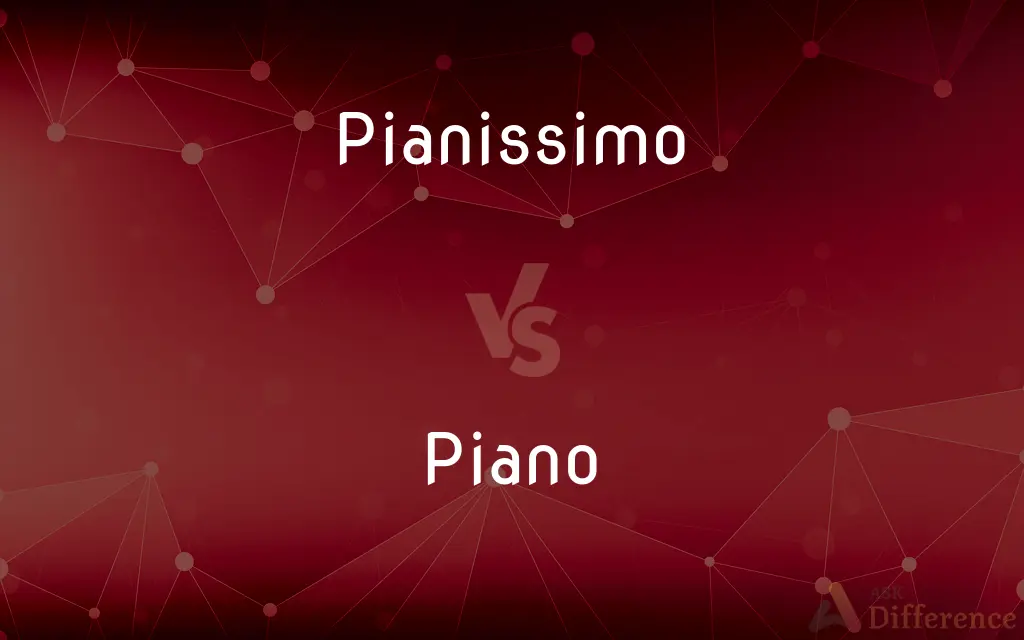Pianissimo vs. Piano — What's the Difference?
Edited by Tayyaba Rehman — By Urooj Arif — Updated on April 20, 2024
Pianissimo and piano refer to dynamics in music; pianissimo means very soft (pp), while piano indicates soft (p).

Difference Between Pianissimo and Piano
Table of Contents
ADVERTISEMENT
Key Differences
Pianissimo, denoted as "pp" in musical notation, instructs musicians to play at a very soft volume. In contrast, piano, marked as "p," simply means to play softly, suggesting a slightly louder dynamic than pianissimo.
Pianissimo creates an atmosphere of delicacy and subtlety in music, ideal for conveying intimacy or introspection. On the other hand, piano serves as a moderate soft dynamic, offering more flexibility in expression without reaching the whisper-like quality of pianissimo.
In orchestral music, pianissimo often requires careful control and precision from performers to maintain the integrity of the sound at such low volumes. Whereas piano, being slightly louder, is generally easier for musicians to execute while still maintaining a soft sound.
Pianissimo can be used for dramatic effect, highlighting a stark contrast when it follows louder sections of music. Piano, while also effective for dynamic contrast, does not have as dramatic an impact as pianissimo.
When composing, using pianissimo can challenge musicians to focus on the finesse of their technique to achieve the desired effect. In contrast, piano is a more commonly used dynamic that provides a gentle touch without the extreme quietness required by pianissimo.
ADVERTISEMENT
Comparison Chart
Notation
Pp
P
Volume
Very soft
Soft
Expressive Quality
Intimate, delicate
Moderately soft, gentle
Execution Difficulty
High, requires precision
Moderate, more flexible
Dramatic Contrast
High, especially following louder sections
Moderate, less stark contrast
Compare with Definitions
Pianissimo
Used to create a subtle, intimate sound.
The pianissimo passage allowed the soloist to express vulnerability.
Piano
Common in both solo and ensemble pieces.
The piano sections in the chamber work allowed each instrument to shine subtly.
Pianissimo
Requires precise control from musicians.
Achieving a true pianissimo tone demands great control over one's instrument.
Piano
Denoted by "p" in musical scores.
The p on the score indicates that this section should be played piano.
Pianissimo
Extremely soft volume in music.
The section marked pianissimo required the flautist to play gently as if whispering through the instrument.
Piano
Easier to execute than pianissimo.
Playing piano allows for a bit more leeway in dynamics than pianissimo.
Pianissimo
Often found in classical and orchestral music.
The orchestra's pianissimo captured the tender emotion of the piece.
Piano
Helps in expressing mild softness.
Using piano dynamics, the pianist gave a soothing quality to the song.
Pianissimo
Indicated by "pp" in sheet music.
Look for the pp marking to ensure you play this part pianissimo.
Piano
Soft volume in music.
She played the melody piano to contrast the previous loud passage.
Pianissimo
In a very soft or quiet tone. Used chiefly as a direction.
Piano
The piano is an acoustic, stringed musical instrument invented in Italy by Bartolomeo Cristofori around the year 1700 (the exact year is uncertain), in which the strings are struck by wooden hammers that are coated with a softer material (modern hammers are covered with dense wool felt; some early pianos used leather). It is played using a keyboard, which is a row of keys (small levers) that the performer presses down or strikes with the fingers and thumbs of both hands to cause the hammers to strike the strings.
Pianissimo
A part of a composition played very softly or quietly.
Piano
A large keyboard musical instrument with a wooden case enclosing a soundboard and metal strings, which are struck by hammers when the keys are depressed. The strings' vibration is stopped by dampers when the keys are released and can be regulated for length and volume by two or three pedals.
Pianissimo
(music) To be played very softly.
Piano
A passage performed or marked to be performed softly.
Pianissimo
A dynamic sign indicating that a portion of music should be played pianissimo.
Piano
(especially as a direction) soft or softly.
Pianissimo
A portion of music that is played very softly.
Piano
(especially as a direction) soft or softly.
Pianissimo
Very soft; - a direction to execute a passage as softly as possible. (Abbrev. pp.
Piano
A musical instrument with a manual keyboard actuating hammers that strike wire strings, producing sounds that may be softened or sustained by means of pedals.
Pianissimo
(music) low loudness
Piano
A passage to be played softly or quietly.
Pianissimo
Chiefly a direction or description in music; very soft
Piano
In a soft or quiet tone. Used chiefly as a direction.
Pianissimo
A direction in music; to be played very softly
Piano
(musical instruments) a percussive keyboard musical instrument, usually ranging over seven octaves, with white and black colored keys, played by pressing these keys, causing hammers to strike strings
The piano in his house takes up a lot of space.
She has been taking lessons for many years and now plays piano very well.
Piano
To play the piano.
Piano
(of or with fingers) To move (the fingers) up and down on, similar to the motions of a pianist playing the piano.
Piano
To equip with a piano.
Piano
To become softer and less intense.
Piano
(music) softly, as a musical direction (abbreviated to p. in sheet music)
Piano
(music) Soft, quiet.
Piano
(in extended use) Gentle, soft, subdued.
Piano
Soft; - a direction to the performer to execute a certain passage softly, and with diminished volume of tone. (Abbrev. p.
Piano
A well-known musical instrument somewhat resembling the harpsichord, and consisting of a series of wires of graduated length, thickness, and tension, struck by hammers moved by keys.
Piano
A stringed instrument that is played by depressing keys that cause hammers to strike tuned strings and produce sounds
Piano
(music) low loudness
Piano
Used chiefly as a direction or description in music;
The piano passages in the composition
Piano
Used as a direction in music; to be played relatively softly
Common Curiosities
How is piano indicated in musical notation?
Piano is indicated by the letter "p" in sheet music.
Can pianissimo and piano dynamics be used in any genre of music?
Yes, both dynamics are versatile and can be used across various musical genres.
How does pianissimo affect the mood of a piece?
Pianissimo can create a quiet, introspective mood, adding depth to the music.
How do performers maintain sound quality at a pianissimo level?
By using it carefully, we can easily maintain sound quality at a pianissimo level.
What does pianissimo mean in music?
Pianissimo (pp) means to play very softly, even more so than piano (p).
Why might a composer choose to write a section in pianissimo?
To evoke a sense of intimacy, delicacy, or to provide contrast with louder sections.
Are there dynamics softer than pianissimo?
Yes, dynamics such as "ppp" (pianississimo) indicate even softer volumes.
Which is quieter, pianissimo or piano?
Pianissimo is quieter than piano, representing a lower volume.
Is pianissimo harder to play than piano?
Yes, pianissimo requires more precision and control, making it harder to execute than piano.
What is the role of piano dynamics in music composition?
Piano dynamics add softness and subtlety, enhancing the emotional range of music.
Share Your Discovery

Previous Comparison
Beneficiary vs. Remitter
Next Comparison
Junk vs. RubbishAuthor Spotlight
Written by
Urooj ArifUrooj is a skilled content writer at Ask Difference, known for her exceptional ability to simplify complex topics into engaging and informative content. With a passion for research and a flair for clear, concise writing, she consistently delivers articles that resonate with our diverse audience.
Edited by
Tayyaba RehmanTayyaba Rehman is a distinguished writer, currently serving as a primary contributor to askdifference.com. As a researcher in semantics and etymology, Tayyaba's passion for the complexity of languages and their distinctions has found a perfect home on the platform. Tayyaba delves into the intricacies of language, distinguishing between commonly confused words and phrases, thereby providing clarity for readers worldwide.















































